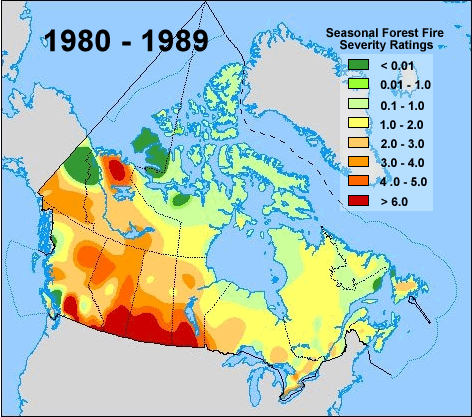"Changes in the wildfire regime have a significant impact on a local and global scale and therefore on the climate as well. It is therefore important to understand how the mechanisms which shape these wildfires work in order to be able to make predictions on what will change in future," explained PD Dr. Volker Grimm of the UFZ in a media release.
The scientists evaluated data on fires greater than 200 hectares from the Canadian Forest Service from 1959 to 1999. The data showed that three ecozones in Canada are close to a turning point: the Hudson Plains south of the Hudson Bay, the Boreale Plains in the Mid-West, and the Boreale Shield which stretches from the Mid-West to the East coast and is therefore the largest ecozone in Canada. The Boreale Shield is the closest to the turning point.
Looking at the data for the Boreale Shield more closely, the researchers found that around 1980 the average size of the fires in this part of the provinces of Alberta, Saskatchewan and Manitoba tripled rapidly.
"In our opinion this is a sign that there are also threshold values for forests above which the wildfire regime drastically changes," reports Volker Grimm. "It is likely that the Boreale Plains have in recent decades, particularly around 1980, experienced a change to a system characterised by wildfires. This has fundamental repercussions for the environment and the combating of wildfires. Small changes in the fire propagation parameters have a great impact on the size of the fires."
The gradual changes that accompany climate change can result in an abrupt and sharp increase in the size of the fires, argue the researchers.
From the abstract for the paper - Understanding Shifts in Wildfire Regimes as Emergent Threshold Phenomena by Richard D. Zinck, Mercedes Pascual, and Volker Grimm published in The American Naturalist DOI: 10.1086/662675.
Transitions across this critical threshold imply abrupt and pronounced increases in average fire size. The model predicts that large regions in Canada are currently close to this transition and might be driven beyond the threshold in the future. We illustrate this point by analyzing the time series for large fires (>199 ha) from the Canadian Boreal Plains, found to have shifted from a subcritical regime to a critical regime in the recent past. By contrast to its predecessor, the model also suggests that a critical transition, and not self-organized criticality, underlies forest fire dynamics, with implications for other ecological systems exhibiting power-law-like patterns, in particular for their sensitivity to environmental change and control efforts.
The researchers are also investigating parallels with disease propagation: whether fuel reduction strategies can work in a similar way to vaccinations against the spread of disease.
Wildfires contributing to permafrost thaw, methane release
Another threat to the climate is posed by increasing wildfires leading to more rapid thaw of the permafrost, releasing methane, a greenhouse gas 20 times more powerful than cabon dioxide. "I maintain that the fastest way you’re going to lose permafrost and release permafrost carbon to the atmosphere is increasing fire frequency," said Michelle C. Mack, a University of Florida scientist who is studying the Alaskan Anaktuvuk fire that ocurred in 2007. "It’s a rapid and catastrophic way you could completely change everything." reported the New York Times in As Permafrost Thaws, Scientists Study the Risks. Read her concluding statement in her research letter published in Nature 28 July 2011 - Carbon loss from an unprecedented Arctic tundra wildfire (PDF).
Our observations of Carbon loss from the Anaktuvuk River fire support the idea that tundra fires have the potential to release large amounts of Carbon and decrease landscape Carbon stocks, having an immediate impact on atmospheric Carbon and climate that is rapid in comparison to other potential climate change feedbacks from tundra ecosystems. Although the future trajectory of ecosystem recovery in the Anaktuvuk River fire scar is yet unknown, most of the plausible short- and long-term scenarios lead to amplification of climate warming.
A similar dramatic increase in wildfires due to climate change threatens the forests of Yellowstone National Park. Climate change will also cause an increase in extreme fire-weather in Australia.
Canada withdraws from Kyoto Protocol
The Canadian environment minister Peter Kent announced Canada's withdrawal from the Kyoto protocol on December 12 in a statement from the House of Commons. Canadian carbon emissions are up 35% since 1990, despite a target under the protocol of 6% lower than 1990 levels by 2012, according to an AFP report.
Sources:
- Helmholtz Centre for Environmental Research media release 16 December 2011 - Rapid rise in wildfires in large parts of Canada?
- Understanding Shifts in Wildfire Regimes as Emergent Threshold Phenomena (abstract) by Richard D. Zinck, Mercedes Pascual, and Volker Grimm published in The American Naturalist DOI: 10.1086/662675.
- Factors influencing national scale wildfire susceptibility in Canada, 20 November 2011 (abstract) doi:10.1016/j.foreco.2011.10.031
- Nature, 28 July 2011 - Carbon loss from an unprecedented Arctic tundra wildfire (PDF)
- Atlas of Canada - Animation of the Projected Changes in Forest Fire Severity Ratings - Copyright Natural Resources Canada. Permission to reproduce Government of Canada works, in part or in whole, and by any means, for personal or public non-commercial purposes, or for cost-recovery purposes, is not required.


